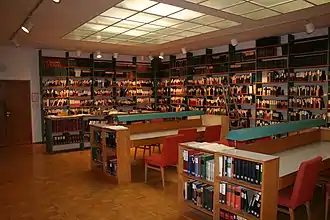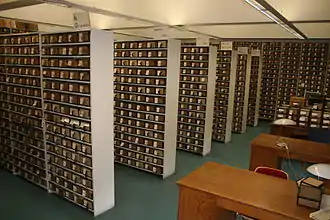

The Thesaurus Linguae Latinae (abbreviated as ThLL or TLL) is a monumental dictionary of Latin founded on historical principles. It encompasses the Latin language from the time of its origin to the time of Isidore of Seville (died 636).
The project was founded in 1894 by Eduard Wölfflin.[1] At the time, the researchers thought it would take up to 20 years to complete the thesaurus.[1] Today, it is expected that the work will be completed around the year 2050. The last fascicle of the P-volume appeared in 2010, and work is currently under way on both N and R. The institution that carries out the work of the dictionary is located in Munich, in the Bavarian Academy of Sciences and Humanities.[2][1] Wölfflin described the entries in the TLL as "biographies" rather than definitions.[1]
The offices of the TLL contain copies of all surviving Latin texts from 600 CE and earlier.[1] The stacks contain boxes that collectively contain about 10 million slips on which is "every surviving piece of writing from the classical period", sorted into usage categories by word.[1] For example, there are about 90,000 slips for the word 'et' and 50,000 for the word 'non'.[1] These are used as source material to create entries for each word in the thesaurus.
In 2019, the TLL posted PDF copies of each entry on its website.[1]
References
Citations
- 1 2 3 4 5 6 7 8 Quinn, Annalisa (2019-11-30). "Latin Dictionary's Journey: A to Zythum in 125 years (and counting)". The New York Times. Retrieved 2019-12-01.
- ↑ Holmes, N. Questions and Answers, Thesaurus Linguae Latinae, Bayerische Akademie der Wissenschaften. 12/7/2007.
Sources
External links
- Thesaurus Linguae Latinae website
- Chris Smith: Thesaurus Linguae Latinae: How the World’s Largest Latin Lexicon is brought to Life. In: De Gruyter Conversations, 05. Juli 2021.
 Media related to Thesaurus Linguae Latinae at Wikimedia Commons
Media related to Thesaurus Linguae Latinae at Wikimedia Commons